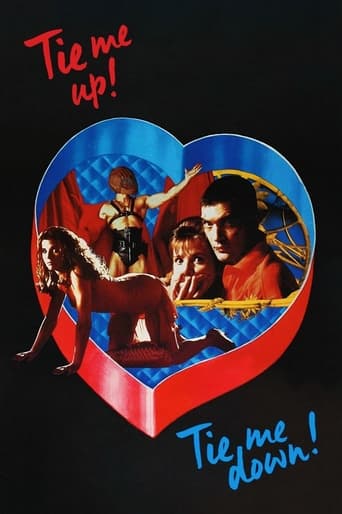

Finally saw one of the films of Pedro Almodovar it this work which was rightfully called "Tie Me Up! Tie Me Down!" As it's a good little take and spin on getting happiness and returning to it after being lonely and put away like the movies central character Ricky. Anyway Antonio Banderas is Ricky a former prisoner and put away mental patient who once had a one night stand with Marina(Victoria Abril)a now sexy porn movie star. As being put away for many years Ricky has developed an unhealthy obsession for Marina as he wants as soon as he gets out to hook back up with her and marry her! So upon release Ricky takes Marina hostage almost like a kidnap victim a damsel in distress, the scenes are funny and dark with Marina being tied up and having her mouth taped with duct tape all while resting in bed! This all leads to a crazy romance and once again some very hot and passionate steam like sex! All of this now leads to escape for both. Overall not everyone's cup of tea still this picture is provocative and a hot twisted take on love and obsession, so if that kind of thing is your poison taste then give this work a watch.
... View MoreRicky (Antonio Banderas) is released from a mental hospital. He is obsessed with former porn actress Marina Osorio (Victoria Abril) who he slept with once before. She's trying to go straight and working for a lascivious director. Ricky breaks into her home and takes her prisoner. He wants to make her fall in love with him but she doesn't remember him.Filmmaker Pedro Almodóvar delivers another sexually daring movie. The most memorable scene is probably Marina in the bathtub with a scuba diver toy. Both Banderas and Abril are compelling leads. If anything, I would like for them to spend the entire time in the apartment as a two person play. It would be intriguing to see Almodóvar push his writing skills and let his two stars play with the material.
... View MoreI'm no prude, not even close. And I have little time for most of the hysterical cries of modern middle-class feminism. But I believe violence-against-women to be one of the worlds' most profound (and common) problems and as such must be handled with care & respect in artistic mediums. There are many dumb movies which feature such violence but are justly ignored by the discerning viewer. Once Were Warriors & Nil By Mouth are two films which deal with this issue in an admirable way.Almodóvar is someone who's raved about by the intellectual film community, and as such there is a responsibility for the film critic to question his values where appropriate. His films glorifies the woman-as-victim image: or rather the woman-as-plaything (see also La piel que habito). Tie Me Up champions this value, glamourises it, and worst of all, romanticises it. It's the male-chauvinist fantasy those mad fems have been warning us about all along, except they probably don't recognise it themselves as it's Almodóvar.If you understand the psychology of women in abusive relationships, it's the feeling of being trapped and of being fooled by the perceived romanticism of it which prevents many from protecting themselves. It's a genuine problem, with lots of potential in the film medium as a dramatic premise. This film does the very opposite of shining a light on this issue, it merely encourages it. Those that claim detractors "miss the point", or "don't understand the irony" are missing the point themselves: there is no irony. It is what it is, and it is morally-irresponsible.Still, the film-buff in me doesn't want to rate it quite a 1/10: the acting from both leads is very good, and the film's technicolour is appealing.Recommended for those who want to decide for themselves.Not recommended if the negative reviews here have convinced you.
... View MoreAfter watching Tie Me Up, Tie Me Down I have came to realize how mainstream society believes irrational, criminal and bad behavior is actually good behavior. I became quite disturbed from this movie. While this movie was shot very well and the script was very well written, the acting was superb, the basis of the story was off mark. After reading other reviews stating this movie is misunderstood, blah blah this movie is not misunderstood. I don't see how anyone could rationalize the behavior of Ricky in this movie. Here is this guy that gets out of a mental hospital and proceeds to stalk this girl, break into her apartment, knock her out and eventually tie her up all in the name of love. What's really sickening is the fact that Marina starts to like him. I don't know if this is due to a case of Stockholm Syndrome or what but this movie did not sit well with me. We constantly hear about how guys treat girls so poorly in society but after watching this movie it's no wonder why guys treat girls so bad after watching such distasteful movies such as this one. This movie pretty much states that if you want a girl to like you, you need to physically harm her, treat her like crap and tie her up against her will. I do not recommend this film to anyone that has somewhat of a morale compass.
... View More